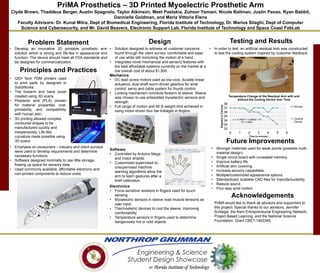
Showcase2016_Poster_BME_Berger-3
- 1. PriMA Prosthetics – 3D Printed Myoelectric Prosthetic Arm Clyde Brown, Thaddeus Berger, Austin Spagnolo, Taylor Atkinson, Meet Pastakia, Zuhoor Yamani, Nicole Ballman, Justin Pavao, Ryan Babbit, Dannielle Goldman, and Maria Vittoria Elena Faculty Advisors: Dr. Kunal Mitra, Dept of Biomedical Engineering, Florida Institute of Technology, Dr. Marius Silaghi, Dept of Computer Science and Cybersecurity, and Mr. David Beavers, Electronic Support Lab, Florida Institute of Technology and Space Coast FabLab Problem Statement • Develop an innovative 3D printable prosthetic arm solution which is strong and life-like in appearance and function. The device should meet all FDA standards and be designed for commercialization. Testing and Results Acknowledgements PriMA would like to thank all advisors and supporters to this project. Special thanks to our advisors, Jennifer Schlegel, the Kern Entrepreneurial Engineering Network, Project Based Learning, and the National Science Foundation, Grant CBET-1403345. • In order to test, an artificial residual limb was constructed to test the cooling system inspired by customer feedback. Principles and Practices Design • Solution designed to address all customer concerns found through the client survey: comfortable and ease of use while still mimicking the motion of a hand. • Integrates novel mechanical and sensory features with the best affordable systems currently on the market at a low overall cost of about $1,500. Mechanics • DC lead screw motors used as low-cost, durable linear actuators; dual shaft worm-driven gearbox for wrist control; servo and cable system for thumb control. • Locking mechanism connects forearm to sleeve. Sleeve was chosen to use embedded myoelectric sensors and strength. • Full range of motion and 50 lb weight limit achieved in using motor-driven four bar linkages in fingers. Future Improvements Software • Controlled by Arduino Mega and motor shields. • Customized supervised-to- unsupervised machine learning algorithms allow the arm to learn gestures after a brief calibration. • Stronger materials used for weak points (possible multi- material design). • Single circuit board with increased memory. • Improve battery life. • Artificial skin covering. • Increase sensory capabilities. • Multiple/customized appearance options. • Standardized, scalable CAD files for manufacturability. • Reduce sound. • Four-way wrist motion. • QIDI Tech FDM printers used to print parts by designed in SolidWorks. • The forearm and hand cover created using 3D scans. • Polylactic acid (PLA) chosen for material properties, cost, printability, and compatibility with human skin. • 3D printing allowed complex contoured shapes to be manufactured quickly and inexpensively. Life-like curvature made possible using 3D scans. • Emphasis on consumers – industry and client surveys were used to develop requirements and determine necessary functions. • Software designed minimally to use little storage, freeing up space for sensory data. • Used commonly available, affordable electronic and non-printed components to reduce costs Electronics • Force-sensitive resistors in fingers used for touch sensing. • Myoelectric sensors in sleeve read muscle tensions as user input. • Thermoeletric devices to cool the sleeve, improving comfortability. • Temperature sensors in fingers used to determine dangerously hot or cold objects. y = -0.1687x2 + 0.0808x + 37 R² = 0.9651 32 33 34 35 36 37 38 0 1 2 3 4 5 6 DegreesinCelcius Time (in minutes) Temperature Change of the Residual Arm with and without the Cooling Device over Time Normal Cooling Device